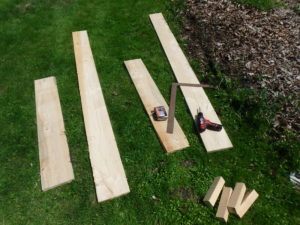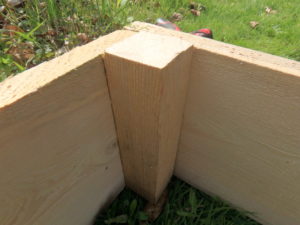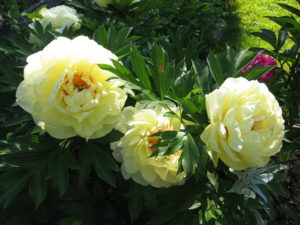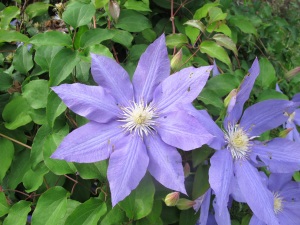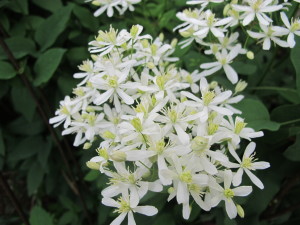Tips for Building Raised Beds for Your Garden
As an avid gardener I am always looking for new places to plant. I own a couple of acres of land, but over the past 49 years I’ve filled virtually every square inch of useable space with something – vegetables, flowers, trees and a little lawn. Recently I built a wood-sided raised bed to give me more room for flowers.
Raised beds are good for many reasons:
- The lawn can’t so easily creep into them.
- You can design/blend the soil to be anything you want – sandy, rich or heavy; acidic, neutral or alkaline.
- They drain well, even if built over a soggy base.
- You can place them on the lawn without needing to remove the sod (it will die off).
I built a raised bed recently using rough sawn hemlock I bought from a local sawyer. Rough sawn must means that the wood is cut, but not planed. So a 1”x 8” plank is a full inch thick, not the ¾ inch that you would get at a lumber yard or home center – and hence stronger, and longer lasting.
Hemlock is full or resins that resist rot. It is not as good as cedar, but it is much cheaper. You can buy planed cedar that is a full inch thick, it is called “five-quarter”, and is available at most places that sell lumber. But it’s pricey. You can use plain old pine boards from the lumber yard, but they tend to rot sooner.
Then there is pressure treated wood and synthetic boards made from re-cycled pop bottles that is said to last 50 years or so. Years ago pressure treated wood leached arsenic into the soil, but newer technologies have eliminated that as a problem, I have read. Still, I am personally leery of using it for any food or herbs. I try to avoid chemicals whenever possible.
What size bed should you build? That depends on your space and the reach of your arms. I am relatively tall, so I made my bed 4 feet wide. Smaller people might be more comfortable weeding or planting a bed that is just 3 feet wide. I made mine 8 feet long, but 10 feet or even 6 feet might suit you – or your space – better.
Here’s how I built mine: I cut 2 hemlock boards 8 feet long for the sides, and 2 boards 4 feet long for the ends. Then I cut a piece of wood 2 inches by 2 inches into 8-inch long sections, 4 of them. You can use a 2-by-4 instead of 2 by 2 if you have one.
Instead of using nails I find it easier to work with screws. I used some that were an inch and a half long. Driving screws into dense wood like hemlock or cedar can strain a drill. If you find that the screws don’t easily go all the way in, you can pre-drill holes a little smaller in diameter than the screws. Or you can lubricate the screws by dragging them across a bar of soap (moisten it a little to soften it). That helps a lot.
Those 8-inch pieces of 2 x 2 are for the corners, to make them sturdy, square, and to allow the screws to bite into something more substantial than a 1-inch plank. I screwed them onto the ends of the long planks, then stood up the planks and screwed the short planks into the corner pieces. That is easier to do if you have someone helping you, but you can always lean the long planks against something to keep them vertical if you are working alone.
If you don’t feel handy or don’t have a saw, you can buy brackets that will hold either a 2-inch or 1-inch thick planks. Gardener’s Supply Company sells a variety of brackets designed for 2-inch thick lumber, and Lee Valley Tools has just one type and it is for 1-inch thick lumber (from a lumber yard, so they won’t work on the thicker rough sawn lumber I used). Both companies make nice products, and will ship to your door. Your local lumber yard will cut the boards you need to the length you want. Just ask.
I started this project because I wanted to give perfect soil and sunlight to a new peony I bought from Cider Hill Gardens in Windsor, Vermont. It is one called “Garden Treasure”, an Itoh peony. These peonies are crosses of regular herbaceous peonies with tree peonies.
Itoh peonies can bloom in colors other peonies could not even dream of: yellow with peach, for example. And they can bloom for a full month, producing 50 blossoms or more at maturity. But they are expensive, so I have never gotten one – until this year.
In that same bed I am moving some old daffodils that have stopped blooming. Nearly 50 years ago I dug some old bulbs from my parents’ home in Woodbridge, Connecticut and moved them to my home in New Hampshire. In recent years the leaves have appeared, but not any blossoms.
Those daffodils have been growing in a place that is getting shadier each year and there is more root competition, too. So I will dig them up and move them into this new bed, which offers full sun. I will also treat them to a dose of Bulb Booster to enrich their soil. What I do to pamper my plants!
Reach Henry at henry.homeyer@comcast.net or P.O. Box 364, Cornish Flat, NH 03746. Please include a SASE if wishing a response by mail.
Fourth of July
Among my earliest memories is one from a Fourth of July celebration back when I was just a tadpole – perhaps 1949. My sister and I sat on the hood of our parents’ 1938 Buick, a big black sedan, and watched fireworks way past my bedtime. Red, white and blue rockets zoomed skyward, filling us with awe. Now, all these years later, I am awed by red, white and blue flowers that climb up towards the sky. No booms, but plenty of blooms. Right now many clematis vines are ready to show off in patriotic colors in your garden.
Clematis is a showy vine that confounds many. Unlike most flowers, these come in several different colors – including red, white and blue. Surely you’ve seen showy 4- to 6-inch blossoms on vines growing up trellises. Those were probably clematis. But sometimes gardeners plant the vines and are disappointed. They can be a little fussy. In fact, I have two that I planted earlier this summer that seem to be sulking. I know, however, that within a year or two (or sooner, hopefully) they will start growing vigorously. I have provided them with good soil, some organic fertilizer and a structure they can twine around.
What clematis vines need are hot tops and cool bottoms. They require rich, slightly moist soil that stays cool, but plenty of hot sunshine on the ascending vines. To do that, mulch the roots well with chopped leaves or ground bark mulch. And plant a medium-sized perennial – or more than one – in front of the vine to shade the soil from the afternoon sun, helping to keep the roots cool. An astilbe is about the right size, or perhaps a Shasta daisy.
I called plantsman Gary Milek of Cider Hill Gardens and Galleries in Windsor, VT for suggestions for good patriotic red, white and blue clematis varieties. He said there are two great red ones: ‘Niobe’ and ‘Cardinal Wyszynski’. The latter one is a Polish variety that is free flowering, meaning that it will keep blossoming and growing taller all summer, a definite plus.
White clematis include a variety called ‘Henryi’, which since it shares a name with me, I should get. Gary Milek said it can easily grow 8 to 10 feet up from the ground in one year. Another white one he likes is ‘Gillian Blades’, which has white blossoms and yellow anthers.
Right now I have a white bush-type clematis in bloom, known as ground clematis or by its scientific name, Clematis recta. This gets to be about five feet tall, and unless it is very well supported, it then flops over. Mine is growing in front of a stone retaining wall facing east, so it gets little afternoon sun. My bush is nearly six feet wide right now, but will die to the ground in winter.
The individual flowers are not impressive: each 5-petaled blossom is only an inch and a half across. But there are lots of them. Flower clusters are loaded with them, and the stems are nice and strong, hence great in a vase, and keep well when picked.
Come fall, I’ll have another round of white clematis blossoms when my ‘Sweet Autumn’ clematis (Clematis paniculata) comes into bloom. Like the bush-type, this clematis has small blossoms, and lots of them. And they are fragrant, or can be. I had one previously that was not fragrant, but generally they are.
Of the blue or purple-blue clematis, a variety called ‘Jackmanii’ is well known and very popular. It is tough as nails, thriving even after hard winters. Like many, but not all, clematis, it dies to the ground each fall. You should prune it back to within a foot of the ground in the fall or first thing in the spring. Other clematis vines do survive the winter, and should just be trimmed to neaten them up after their early summer blooming.
According to Gary Milek, a truer blue (for the Fourth of July theme) is ‘The President’. It will grow 8 to 12 feet tall, and have two flushes of blooms: early summer (May-June) and then again in fall (September-October). Like many clematis, it has good winter interest: the seed heads are fluffy white, persistent structures.
Other great climbers in patriotic colors? Climbing hydrangea (Hydrangea anomala,subspecies petiolaris) is a fabulous white vine. It will attach itself to brick or rock walls, but needs help to climb a wooden wall. These great vines are slow to start growing after planting, but really get vigorous after 5 or 6 years. Your patience will be rewarded. As they climb, they extend short branches, loaded with big white flower panicles that seem to defy gravity. And they thrive in shade, or part shade. Great for the north side of a barn, where I have mine.
Then there are the red roses. The Canadian Explorer series, developed in Ottawa, are very nice. ‘William Baffin’ is my favorite climber. He grows 8 to 10 feet high, and is technically a deep pink. But that’s close enough for me.
So if you want something to grow up to the sky, there are plenty of choices. I just wish I had that 1938 Buick (which went to the junk yard in 1961). Sigh. Maybe I’ll go buy another climbing clematis to console myself.
Henry is the author of 4 gardening books, and a children’s chapter book about a boy and a cougar, Wobar and the Quest for the Magic Calumet. His web site is www.Gardening-Guy.com.



